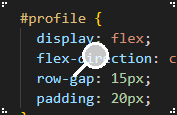Critiques on markup, styling and script decisions made on webpages

<div id="footer__section" />
A footer under the 'find me' section provides spacing to adjust the viewer to the correct eye level to consider the former mentioned section. This footer uses added white space to achieve this.
<div class="codebox">
<p class="margin0"></p>
</div>
To emulate the gap of 1 tab or 4 normal spaces inside the codebox, an html element class of <marginN> was created to denote a spacing, where N represents a tab space (representing 4 individual normal spaces).
:root {
--ff-primary: 'Noto Sans', sans-serif;
--ff-secondary: 'Inconsolata', monospace;
--fw-reg: 300;
--fw-bold: 900;
}
Custom properties allow standardised modifications to html. html can be stylised using custom properties so that texts inside body and pages can be displayed correctly and uniformly. Alternatively, it provides a system to bring customized colours to html elements.
:hover{}
:focus{}
Pseudo-classes like the ones above transform how a particular html element is displayed when it is selected as the centre of attention. The highlighting is done by styled classes inside the html element.
@media (max-width: 900px) {}
In order for the contents of the webpage to be displayed correctly in an internet browser whilest on a desktop ratio, particular styling for this aspect ratio is required to be implemented on html elements.
p.margin1 {
position: relative;
margin: 0 0 0 20px;
z-index: 2;
color: lightgray;
overflow-x: auto;
}
The example here of 'margin1' denotes to styling the html content to be 20px right of the initial margin. The margin sizes for other classes like this one are in proportional to each other.
The names for element tags for html, class names for css, variable names in js could be improved to provide clarity to assist development such as in composition.